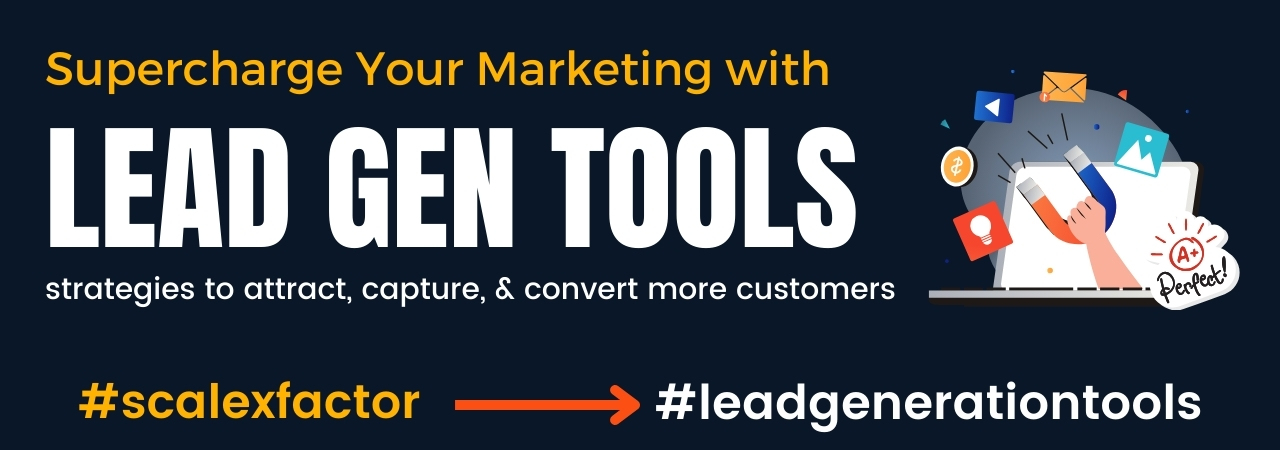Are you ready to take your marketing game to the next level? If you want to get more customers and grow your business, you’ve come to the right place. In this article, we’ll explore how you can boost your marketing results using the latest and greatest lead generation tools and new features.

Whether you’re a seasoned marketer or just starting, these tools and features can help you reach more people and turn them into loyal customers.
Chapter 1: What Is Lead Generation?
Before we dive into the exciting world of lead generation tools and features, let’s first understand what lead generation is. In simple terms, lead generation is the process of attracting potential customers, or leads, and capturing their contact information. These leads can then be nurtured and converted into paying customers over time.
Chapter 2: Why Is Lead Generation Important?
You might be wondering why lead generation is so crucial for your business. Well, the answer is simple: it helps you find people who are genuinely interested in what you have to offer. Instead of casting a wide net and hoping to catch some fish, lead generation allows you to target your efforts on individuals who are more likely to become customers.
Chapter 3: The Power of Lead Generation Tools
Now, let’s get into the exciting part – lead generation tools. These tools are like your secret weapons in the world of marketing. They help you streamline your efforts, save time, and most importantly, generate more leads. Here are some powerful lead generation tools you should consider using:
- Email Marketing Software: This tool allows you to send targeted emails to your leads, keeping them engaged and informed about your products or services.
- Social Media Advertising: Platforms like Facebook and Instagram offer powerful advertising options that can help you reach your ideal audience.
- Content Marketing Tools: Create valuable content that attracts potential customers, such as blog posts, videos, and infographics.
- SEO Tools: Optimize your website to appear higher in search engine results, making it easier for people to find you.
- Lead Capture Forms: These forms, often found on websites, allow visitors to provide their contact information in exchange for valuable content or offers.
- CRM (Customer Relationship Management) Software: Keep track of your leads and their interactions with your business to personalize your marketing efforts.
Chapter 4: New Features for Better Results
In addition to these essential lead generation tools, many platforms are constantly updating and adding new features to help you get even better results. Let’s explore some of these new features:
- AI-Powered Analytics: Some tools now use artificial intelligence to analyze your data and provide insights on how to improve your marketing strategy.
- Chatbots: These automated chat agents can engage with website visitors 24/7, answering questions and capturing leads even when your team is asleep.
- Personalization: Tailor your marketing messages to individual leads based on their behavior and preferences, increasing the chances of conversion.
- A/B Testing: Test different versions of your marketing materials to see which ones perform better and make data-driven decisions.
- Mobile Optimization: With more people accessing the internet on their mobile devices, ensuring your marketing materials are mobile-friendly is crucial.
Chapter 5: How to Get Started
Now that you know about the power of lead generation tools and the latest features, it’s time to take action. Here’s a step-by-step guide on how to get started:
Step 1: Define Your Target Audience Before you can start generating leads, you need to know who your ideal customers are. What are their interests, demographics, and pain points? This information will help you create content and campaigns that resonate with them.
Step 2: Choose the Right Tools Select the lead generation tools that align with your marketing goals and budget. Some tools offer free versions with limited features, while others require a subscription.
Step 3: Create Compelling Content Content is king in the world of lead generation. Develop high-quality content that provides value to your audience. This could be blog posts, videos, ebooks, or webinars.
Step 4: Implement SEO Strategies Optimize your website and content for search engines. This will increase your visibility and attract organic traffic.
Step 5: Build Landing Pages and Forms Design attractive landing pages that encourage visitors to take action, such as signing up for your newsletter or downloading a free resource. Use lead capture forms to collect their information.
Step 6: Promote Your Content Use social media, email marketing, and paid advertising to promote your content and drive traffic to your landing pages.
Step 7: Nurture Your Leads Once you’ve captured leads, don’t forget about them. Use email marketing and CRM software to nurture your leads with relevant content and offers.
Step 8: Analyze and Optimize Regularly review your lead generation efforts to see what’s working and what needs improvement. Adjust your strategies based on the data you collect.
Chapter 6: Success Stories
To inspire you on your lead generation journey, let’s take a look at some success stories of businesses that have used powerful lead generation tools and new features to boost their marketing results.
Case Study 1: Sarah’s Online Boutique Sarah, the owner of a small online boutique, used Facebook’s advanced targeting options to reach women aged 25-45 who were interested in fashion. She ran a successful ad campaign showcasing her latest collection, offering a special discount to those who signed up for her newsletter. Within a month, Sarah had collected over 1,000 leads and saw a 30% increase in sales.
Case Study 2: James’ Tech Startup James, the founder of a tech startup, integrated a chatbot into his website. This chatbot answered common questions and guided visitors to relevant resources. Within three months, the chatbot had captured 500 leads, and James noticed a 20% decrease in bounce rate on his website.
Case Study 3: Maria’s Blogging Journey Maria, a passionate blogger, started using AI-powered analytics to understand her audience better. With this data, she tailored her content to her readers’ preferences. Within six months, her blog’s traffic doubled, and she saw a significant increase in affiliate marketing revenue.
Conclusion
In today’s competitive market, effective lead generation is essential for business success. By leveraging powerful lead generation tools and embracing the latest features, you can connect with your target audience, capture their information, and ultimately convert them into loyal customers.
Remember, it’s not just about quantity but also about quality. Focus on attracting the right leads, nurturing them, and providing value throughout their customer journey. With dedication and the right tools, you can boost your marketing results and achieve your business goals. So, don’t wait – start your lead generation journey today and watch your business thrive!




